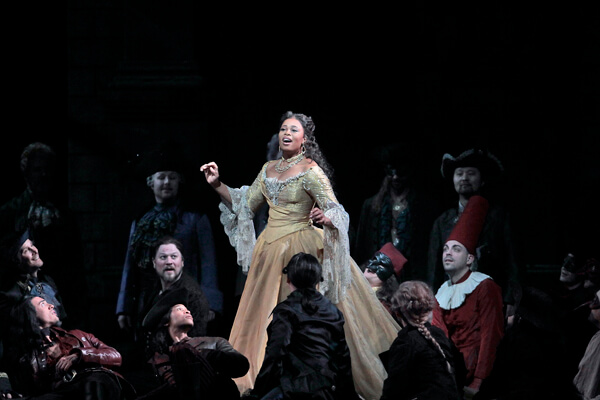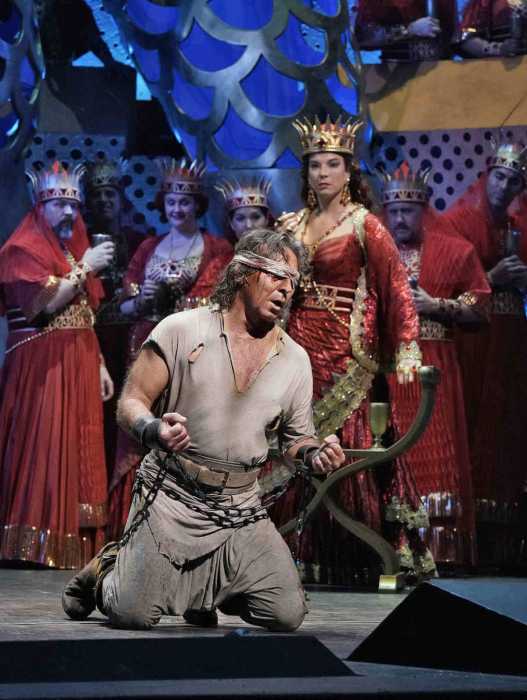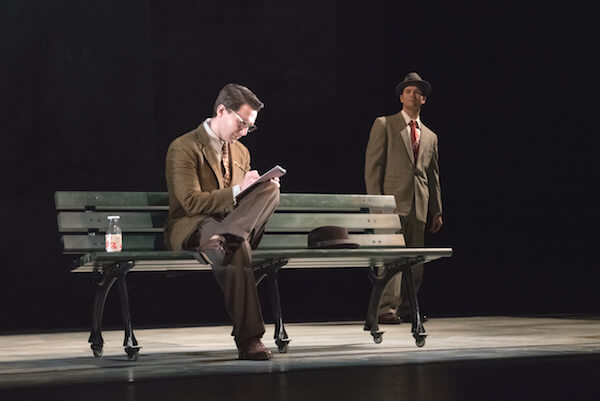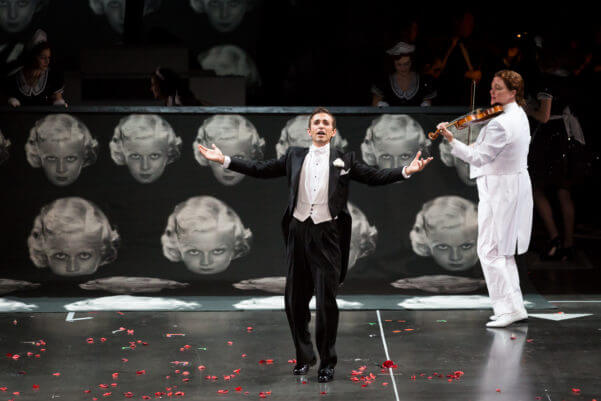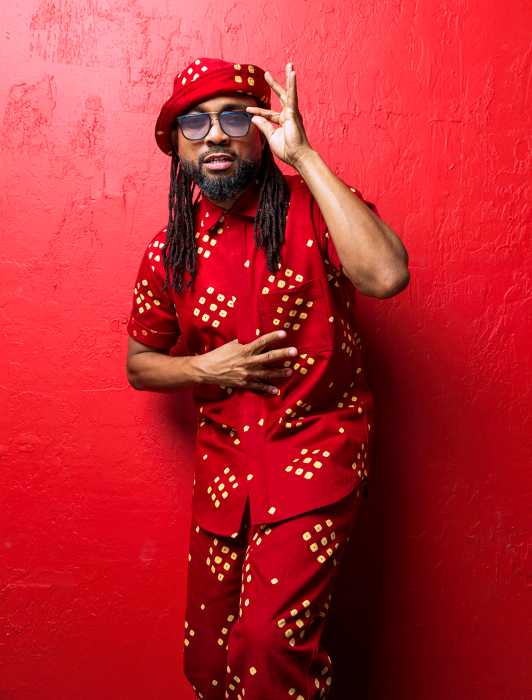Pretty Yende as Juliette in Gounod’s Roméo et Juliette. | KEN HOWARD/ METROPOLITAN OPERA
Peter Gelb has been on the hunt for new operatic stars throughout the decade he has been at the helm of the Metropolitan Opera. Several of his discoveries have not lived up their anticipated potential, and the current galaxy of stars will age and gradually drop from the operatic firmament. (Renée Fleming has indicated that her Marschallin in the new “Der Rosenkavalier” this season at the Met will be her last major operatic engagement.)
One major contender for stardom who has scored immediately with audiences is the young South African soprano Pretty Yende. In 2013, Yende jumped in as a last minute replacement as Comtesse Adèle in Rossini’s “Le Comte Ory” — her sly, naïve charm added an enticing innocence to the character, leavening the vulgarity of Bartlett Sher’s production. Her tone glowed with a silvery radiance, underpinned with a deep purple sheen despite some choppy coloratura passages. A radiantly pure Pamina in “Die Zauberflöte” the following year consolidated this good first impression as did appearances at the Richard Tucker Gala.
This season, Yende has been in career overdrive — two scheduled roles at the Metropolitan Opera (plus a one-off unscheduled star replacement). In between, she made successful guest appearances on the Stephen Colbert and Wendy Williams television shows while promoting her first solo album, “Journey” on Sony Classical.
At the Met, South African soprano Yende wages her bid for stardom
Yende has a fresh, radiant presence and voice that live up to her name and immediately connects with audiences. In person, she is a genial, unaffected charmer — a natural on camera, onstage and off.
This month, Yende enjoyed a dream role — Gounod’s Juliette opposite young American tenor Stephen Costello as her Roméo. The florid opening coloratura flourishes and waltz song were sung in a rather clipped mechanical fashion — I noticed that Yende lacked expressive nuance and that her tone when pressed for brilliance can harden. Her high notes are best when they are allowed to blossom out of the vocal line and aren’t lobbed into the auditorium like hand grenades. In the more lyrical music, Yende began to connect more with the character and phrase with more suppleness yet the text still seemed an accretion on top of the vocal line, not its generating force. Yende, however, looked ravishing — her dark skin contrasting beautifully with her pale silk dresses — and her strong presence contrasted with Costello’s rather callow, blank-eyed Roméo.
Costello’s singing is more confident and secure these days — the slender voice is evenly produced with an easy top register (despite a slight blare in the upper middle break typical of AVA tenor products). He capped his aria and the duel scene with confident high C’s. Yet the tone is pretty but monochromatic in color — there is no depth to the sound, which resembles an upgraded operetta or Gilbert and Sullivan light tenor. His lack of personality contrasted with the surfeit of temperament of his predecessor as Roméo, Vittorio Grigolo — Costello didn’t climb halfway up the wall, never reaching Juliette’s balcony!
The supporting cast was full of upgrades from the original group — Matthew Rose’s mellow Frère Laurent, Margaret Lattimore’s robust Gertrude, Yunpeng Wang’s alert Mercutio, Sean Panikkar’s incisive Tybalt, and Paula Murrihy’s lithe Stéphano. Emmanuel Villaume’s fervent conducting added the emotional punch the two leads sometimes failed to deliver, and Bartlett Sher’s production remains a handsome frame for the lively proceedings.
Last month, on Valentine’s Day, Yende helped prove herself the Met’s new sweetheart soprano by jumping in on short notice replacing the ailing Diana Damrau in the second performance of Bellini’s “I Puritani” (she was not the scheduled cover). Bel canto is driven by voices, and Yende’s full extensive tone, radiant high notes, and youthful verve added star power to a rather faded, uneven revival. Here I noticed an artistic problem with Yende’s singing — it seems note-driven rather than word-driven. It was here I first noticed a disconnection between the meaning of the text and the shaping and coloring of the musical phrase that makes her sound generic and expressively blank at times. Rossini and Mozart have the vocal expression built into their intricately wrought musical structures, but later Romantic music needs a more personal, expressive touch and Yende seemed rather unformed here.
Javier Camarena’s Arturo had this personal touch with long lines of cantilena spun sweetly on the breath and arching high phrases that crested on radiant high D’s. The lower-voiced men made a lesser impression — Alexei Markov sounded snarly but virile as Riccardo while Luca Pisaroni’s Giorgio (who resembled the heroine’s brother not her uncle) lacked gravitas and depth in tone and presence. The “Suoni la tromba” duet ended with a whimper on a lower note while Markov struggled not to lose his voice. We had a “Puritani” star duo, not a quartet. Benini’s flat routine conducting threw another wet blanket over the proceedings.
Yende kicked off her New York season on January 9 with a rather disappointing revival of “Il Barbiere di Siviglia,” where her Rosina provided the sole star turn in an all-star cast that failed to deliver the goods. Winter colds seemed to have sabotaged Peter Mattei’s Figaro and Camerena’s Almaviva — both came to grief on the final high notes of their entrance arias. Everyone gradually pulled themselves together, showing marked improvement in Act II––– Camarena’s “Cessa di più resistere” rondo finale garnered cheers. Maurizio Muraro’s plummy bass, native diction, and witty acting were boons as Dr. Bartolo but he had limited speed in patter. Basilio’s music didn’t overtax Mikhail Petrenko’s light, shallow bass but that was the limit of his virtues.
Yende alone seemed to be in her element. Stylistically this was a throwback to the old Lily Pons type of canary bird soprano Rosina who threw everything but the kitchen sink into the ornamentation — all the old Estelle Liebling circus tricks presented themselves as well as more original inventions. “Una Voce Poco Fa” was up in the key of F and concluded with a short, thin but very present high F in alt. This retro approach might be offensive to the musicologist but at least added some energy and sparkle to the proceedings. Yende’s Rosina exuded genuine girlish charm and innocent mischief, not too brassy or too knowing. Everyone had an obstacle to overcome with Maurizio Benini’s flat, episodic conducting — the music just lumbered ahead on autopilot as the maestro neglected to shape or contrast individual numbers for comedic point.
In the 2017-2018, season Pretty Yende returns to the Met as Lucia di Lammermoor and as Adina in “L’Elisir d’Amore.” The latter will be shown again in HD for no other apparent reason than Yende is in it. The star rises.

